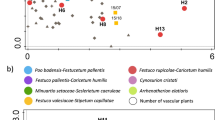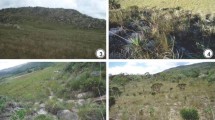Abstract
We have delineated the spatio-temporal plant assemblages prevailing under contrasting environmental conditions at the southernmost part of the North American Graminetum in central México and discuss the relative importance of these factors in determining plant community structure and composition. 353 line-transect samples were collected during 11 years from exclosures and adjacent grazed areas within three Bouteloua-dominated grasslands and one Acacia schaffneri shrubland and analyzed using TWINSPAN. In addition, eight edaphic variables were utilized to evaluate similarities in soil properties among sites, using unweighted-pair groups method. Results from TWINSPAN were translated into mosaic patterns to show the distribution of communities as a function of environmental factors over time. Under no or moderate grazing, summer precipitation promotes an initial differentiation of vegetation into high, low or average rainfall communities. This situation is altered in grasslands degraded by intensive grazing pressure, where rainfall patterns play a subordinate role to that of livestock herbivory. Soil influences are secondary to those of precipitation and grazing in affecting grassland structure and composition. In shrubland, community stability is related to high floristic and edaphic spatial heterogeneity in the face of climatic variability.
Similar content being viewed by others
References
Aguado-Santacruz, G. A. 1987. Cambios en la vegetación de áreas excluidas del pastoreo en los Llanos de Ojuelos. Tesis profesional. Departamento de Biología. Universidad Autónoma de Aguascalientes. Aguascalientes, México.
Aguado-Santacruz, G. A. 1994. Análisis de algunos efectos del pastoreo en agostaderos del Altiplano Central. Campo Experimental 'Vaquerías'. CIPAC/Instituto de Investigaciones Forestales y Agropecuarias. Ojuelos, Jalisco, México. Folleto Técnico No. 4.
Aguado-Santacruz, G. A. & Fierro, L. C. 1988. Respuesta de la vegetación a la exclusión del ganado en tres pastizales de los Llanos de Ojuelos. Manejo de Pastizales-SOMMAP 1: 11-15.
Aguado-Santacruz, G. A. & García-Moya, E. 1998. Environmental factors and community dynamics at the southermost part of the North American Graminetum. I. On the contribution of climatic factors to temporal variation in species composition. Plant Ecol. 135: 13-29.
Aguado-Santacruz, G. A., Luna, M. & Giner, R. A. 1989a. Respuesta de la vegetación y el suelo de un pastizal de los Llanos de Ojuelos al pastoreo inmoderado. Manejo de Pastizales-SOMMAP 1: 1-3.
Aguado-Santacruz, G. A., Luna, M., Ortíz C. & SahagÚn, R. 1989b. Productividad y coeficientes de agostadero en cuatro sitios de pastizal del Altiplano Central bajo condiciones de exclusión y pastoreo. Pp. 36. In: ResÚmenes del 5o Congreso Nacional sobre Manejo de Pastizales. Chihuahua, Chihuahua, México.
Aguado-Santacruz, G. A., Luna, L. M., & SahagÚn, M. R. 1989c. Efecto de la exclusión de ganado y control de arbustivas sobre la productividad de un pastizal. Pp. 110. In: Memorias de la Reunión de Investigación Pecuaria en México 1989. INIFAP-SARH-UNAM-CP-UACh, México, D.F.
Aguado-Santacruz, G. A., Alcocer, R. M. & García, H. M. 1990. Cambios en la cobertura de un pastizal invadido a través de diez años de exclusión y control de arbustivas en los Llanos de Ojuelos. Pp. 43. In: ResÚmenes de la Tercera Reunión Científica Forestal y Agropecuaria-CIFAP/Jalisco. Guadalajara, Jalisco, México.
Arredondo, M. J. T. 1982. Control químico, mecánico y quema controlada de escobilla (Haplopappus venetus) en el Altiplano Central. Pp. 281-284. In: Memorias de la Reunión de Investigación Pecuaria en México 1982. INIP-SARH-UNAM, México, D.F.
Austin, M. P., Williams, O. B. & Belbin, L. 1981. Grassland dynamics in an Australian Mediterranean type climate. Vegetatio 47: 201-211.
Bouyoucos, G. J. 1962. Hydrometer method improved for making particle size analysis of soil. J. Agron. 54: 464-465.
Canfield, R. H. 1941. Application of the line interception method in sampling range vegetation. J. Forestry 34: 388-394.
CETENAL. 1973a. Carta edafológica Ojuelos F-14-C-12 (1:50 000). Instituto de Geografía-UNAM, México, D.F.
CETENAL. 1973b. Carta edafológica Palo Alto F-14-C-11 (1:50 000). Instituto de Geografía-UNAM, México, D.F.
Chapman, H. D. 1965. Cation exchange capacity. Pp. 891-901. In: Black, C. A. (ed.), Methods of soil analysis. American Society of Agronomy, Wisconsin.
Collins, S. L. & Glenn, S. M. 1991. Importance of spatial and temporal dynamics in species regional abundance and distribution. Ecology 72: 654-664.
De la Cerda, M. & Siqueiros, M. 1984. Estudio ecológico y florístico del estado de Aguascalientes. Programa de Investigaciones Biológicas. Serie Flora y Fauna de Aguascalientes, México.
DGDUT. 1982. Diagnóstico general del municipio de Ojuelos para la elaboración de proyectos de desarrollo. Dirección General de Distritos y Unidades de Temporal-SARH. Distrito No. 3, Lagos de Moreno, Jalisco, México.
Duffey, E., Morris, E. G., Sheail, J., Ward, L. K., Wells, D. A. & Wells, T. C. E. 1974. Grassland ecology and wildlife management. Chapman and Hall, London.
García-Moya, E. & McKell, C. M. 1970. Contribution of shrubs to the nitrogen economy of a desert-wash plant community. Ecology 51: 81-88.
García, S. R. 1988. Cambios en la distribución de herbáceas durante la sucesión secundaria en una nopalera de “El Gran Tunal”, San Luis Potosí. Tesis de Maestría en Ciencias. Centro de Botánica. Colegio de Postgraduados. Chapingo, México.
Glenn, S. M. & Collins, S. L. 1993. Experimental analysis of patch dynamics in tallgrass prairie plant communities. J. Veg. Sci. 4: 157-162.
Hanski, I. 1982. Dynamics of regional distribution: the core and satellite species hypothesis. Oikos 38: 210-221.
Herben, T., Krahulec, F. Hadincová, V. & Kovarová, M. 1993. Small-scale spatial dynamics of plant species in a grassland community over six years. J. Veg. Sci. 4: 171-178.
Herman, R. P., Provencio, K. R., Herreramatos, J., & Torrez, R. J. 1995. Resource islands predict the distribution of heterotrophic bacteria in Chihuahuan Desert soils. Appl. Environ. Microbiol. 61: 1816-1821.
Hill, M. O. 1979. TWINSPAN-A FORTRAN program for arranging multivariate data in an ordered two-way table by classification of the individuals and attributes. Cornell University, Ithaca, New York.
Hitchcock, A. S. 1971. Manual of the Grasses of the United States. Sec. Ed. Rev. by Agnes Chase (in two volumes). Dover Publ., New York.
Hobbs, R. J. & Mooney, H. A. 1986. Community changes following shrub invasion of grassland. Oecologia 70: 508-513.
Jackson, M. L. 1976. Análisis Químico de Suelos. Omega, Barcelona, España.
Johnston, A. 1961. Comparison of lightly grazed and ungrazed range in the fescue grassland of southwestern Alberta. Can. J. Plant Sci. 45: 615-622.
Kleiner, E. F. 1983. Successional trends in an ungrazed arid grassland over a decade. J. Range Manag. 36: 114-118.
Mauchamp, A. & Janeau, J. L. 1993. Water funnelling by the crown of Flourensia cernua, a Chihuahuan desert shrub. J. Arid Environ. 25: 299-306.
McIntyre, S. & Lavorel, S. 1994. How environmental and disturbance factors influence species composition in temperate Australian grasslands. J. Veg. Sci. 5: 373-384.
Milchunas, D. G., Lauenroth, W. K., Chapman, P. L. & Kazempour, M. K. 1989. Effects of grazing, topography, and precipitation on the structure of a semiarid grassland. Vegetatio 80: 11-23.
Molina, C. 1990. Caracterización del banco de semillas de un pastizal con diferente grado de deterioro. Tesis de Maestría en Ciencias. Centro de Botánica. Colegio de Postgraduados. Chapingo, México.
Mueller, C. H. 1966. The role of chemical inhibition (allelopathy) in vegetational composition. Bull. Torrey Bot. Club 93: 332-351.
Mueller, C. H. 1969. Allelopathy as a factor in ecological process. Vegetatio 18: 248-357.
Olsen, S. R. & Dean, L. A. 1965. Phosphorus. Pp. 1035-1049. In: Black, C. A. (ed.), Methods of Soil Analysis. American Society of Agronomy, Wisconsin.
Rabotnov, T. A. 1985. Dynamics of plant coenotic populations. Pp. 121-142. In: White, J. (ed.), The population structure of vegetation. Dr. W. Junk. Publishers. The Netherlands.
Reynolds, J. F., Virginia, R. A., Kemp, P. R., de Soyza, A. G. & Tremmel, D. C. 1999. Impact of drought on desert shrubs: effects of seasonality and degree of resource island development. Ecol. Monog. 69: 69-106.
Rice, B. & Westoby, M. 1978. Vegetative responses of some Great Basin shrub communities protected against jack-rabbits or domestic stock. J. Range Manag. 31: 28-34.
Richards, L. A. 1973. Diagnóstico y rehabilitación de suelos salinos y sódicos. Limusa, México.
Schlesinger, W. H., Reynolds, J. F., Cunningham, G. L., Huenneke, L. F, Jarrell, W. M., Virginia, R. A. and Whitford, W. G. 1990. Biological feedbacks in global desertification. Science 247: 1043-1048.
Sneath, P. H. A. & Sokal, R. R. 1973. Numerical taxonomy. W.H. Freeman. San Francisco, California.
Solbrig, O. T. & Orians, G. H. 1977. The adaptive characteristics of desert plants. Am. Sci. 65: 412-421.
Thomas, A. S. 1960. Changes in vegetation since the advent of myxomatosis. J. Ecol. 48: 287-306.
Tiedemann, A. R. & Klemmedson, J. O. 1973. Nutrient availability in desert grassland soils under mesquite (Prosopis juliflora) trees and adjacent open areas. Proc. Am. Soc. Soil Sci. 37: 107-111.
Turner, G. T. 1971. Soil and grazing influences on a salt-desert shrub range in western Colorado. J. Range Manag. 24: 31-37.
Van der Maarel, E. & Sykes, M. T. 1993. Small-scale plant species turnover in a limestone grassland; the carousel model and some comments on the niche concept. J. Veg. Sci. 4: 179-188.
Watt, A. S. 1957. The effect of excluding rabbits from grassland B (Mesobrometum) in Brecdland. J. Ecol. 45: 861-878.
West, N. E. & Gifford, G. F. 1976. Rainfall interception by cool-desert shrubs. J. Range Manag. 24: 171-172.
West, N. E. & Skujins, J. 1977. The nitrogen cycle in North American cold-winter semi-desert ecosystems. Oecol. Plant. 12: 45-53.
Author information
Authors and Affiliations
Corresponding author
Rights and permissions
About this article
Cite this article
Aguado-Santacruz, G., García-Moya, E., Creque, J. et al. Environmental factors and community dynamics at the southernmost part of the North American Graminetum. Plant Ecology 158, 49–63 (2002). https://doi.org/10.1023/A:1014791402791
Issue Date:
DOI: https://doi.org/10.1023/A:1014791402791




